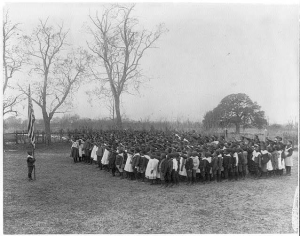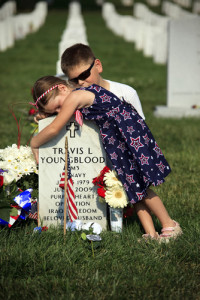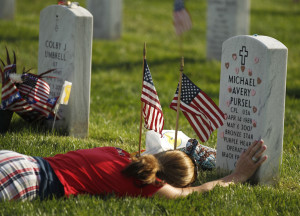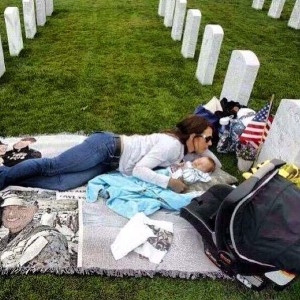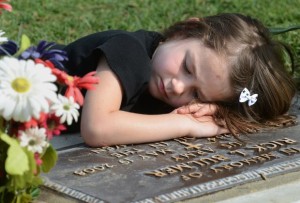On May 1, 1865, Memorial Day was started by former slaves in Charleston, S.C., to honor 257 dead Union soldiers who had been hastily buried in a mass grave in an upscale race track converted into a Confederate prison camp. After the Confederate evacuation of Charleston, black workmen went to the site, dug up the bodies, and worked for two weeks to give them a proper burial as gratitude for fighting for their freedom.
The freedmen cleaned up and landscaped the burial ground, building an enclosure and an arch labeled, “Martyrs of the Race Course.” Then, nearly ten thousand people, mostly freedmen in cooperation with white missionaries and teachers, staged an unforgettable parade of 10,000 people on the slaveholders’ racecourse. At 9am, the procession began and was led by about 3,000 black schoolchildren carrying armloads of roses and singing “John Brown’s Body.”
Several hundred black women then followed with baskets of flowers, wreaths, and crosses. Then came the black men, marching in cadence, followed by contingents of Union infantry and other black and white citizens. As many as possible gathered in the cemetery enclosure; the children sang “We’ll Rally around the Flag,” the “Star-Spangled Banner,” and several other spiritual songs before several black ministers read from scripture. Years later, the celebration would come to be called the “First Decoration Day” in the North.
The old racetrack is gone, but an oval roadway survives on the site in Hampton Park, named for Wade Hampton, former Confederate general and the governor of South Carolina after the end of Reconstruction. The old gravesite of the Martyrs of the Race Course is gone too; they were reinterred in the 1880s at a national cemetery in Beaufort, S.C.
Another touching and unforgettable early Memorial Day celebration happened on April 25, 1866, at Friendship Cemetery in Columbus, Mississippi, where four women met to decorate the graves of fallen Confederate soldiers. Forty Union soldiers were also buried in that same ground, and the women, in a spirit of generosity, decorated those graves as well.
The Columbus event made national headlines. A lawyer in Ithaca, New York, Francis Miles Finch, upon reading about the incident, wrote the following poem, which was published on September 1867 in The Atlantic Monthly.
The Blue and the Gray
By the flow of the inland river,
Where the fleet of iron has fled,
Where the blades of the grave grass quiver,
Asleep are the ranks of the dead.
Under the sod and the dew
Waiting the Judgement Day,
Under the one the Blue,
Under the other the Gray.
Those in the robings of glory,
Those in the gloom of defeat;
All with the battle blood gory,
In the dusk of Eternity meet.
Under the sod and the dew
Waiting the Judgement Day,
Under the laurel the Blue,
Under the willow the Gray.
From the silence of sorrowful hours,
The desolate mourners go,
Lovingly laden with flowers,
Alike for the friends and the foe.
Under the sod and the dew
Waiting the Judgement Day,
Under the roses the Blue,
Under the lilies, the Gray.
So, with an equal splendor,
The morning sunrays fall,
With a touch impartially tender,
On the blossoms blooming for all.
Under the sod and the dew
Waiting the Judgement Day,
Broidered with gold, the Blue,
Mellowed with gold, the Gray.
So, when the summer calleth,
On forest and field of grain,
With an equal murmur falleth,
The cooling drip of the rain.
Under the sod and the dew
Waiting the Judgement Day,
Wet with the rain, the Blue.
Wet with the rain, the Gray.
Sadly but not with upbraiding,
The generous deed was done,
In the storm of the years that are fading,
No braver battle was won.
Under the sod and the dew
Waiting the Judgement Day,
Under the blossoms, the Blue,
Under the garlands, the Gray.
No more shall the war cry sever,
Or the winding rivers be red;
They banish our anger forever,
When they laurel the graves of our dead.
Under the sod and the dew
Waiting the Judgement Day,
Love and tears for the Blue.
Tears and love for the Gray.
****
When you throw back that beer today, don’t forget to make a toast to all the military men, women, and their families for their incredible sacrifice. And never forget that we’re free because so many warriors fought and died to protect our country. And so many are dying and protecting our country at this very moment. All of them are heroes, including their families. Now I’ll drink to that.
